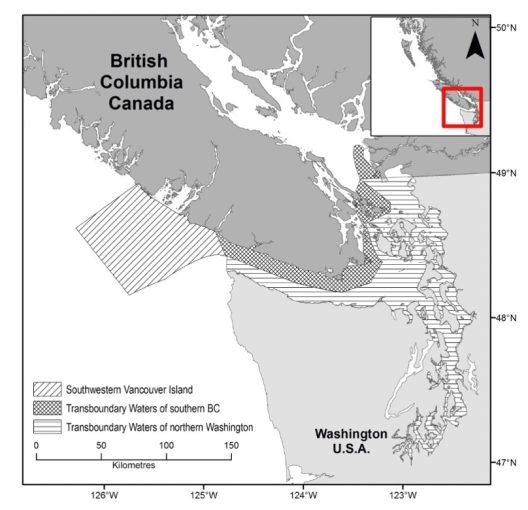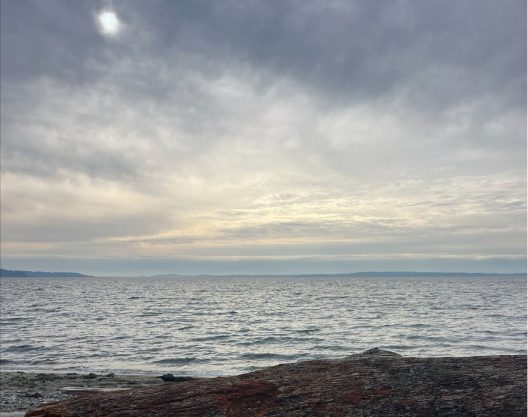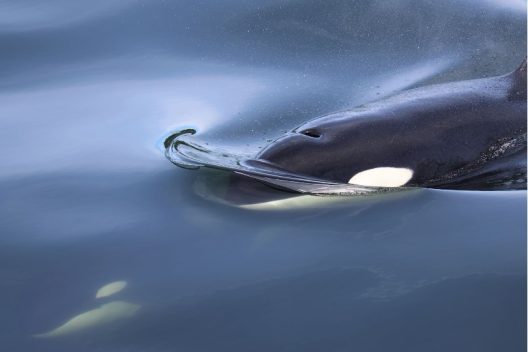Weaknesses in US/Canadian Transboundary Whale Conservation
Killer whales (Orcinus Orca) were designated an endangered species in 2005 by the United States and have shown little to no improvement in population size in the intervening two decades since their listing. One of the most prominent populations of orcas is the Southern Resident Killer Whales (SRKWs) that inhabit the waters of the Salish Sea. With a range from Alaska to central California, these orcas are top predators that are not only significant to their ecosystems but to human cultures and economies as well. For instance, for some cultures, the orca whale symbolizes harmony between people and nature, community, and family. Some Indigenous groups even believe that orcas sometimes purposefully sink canoes to try and be ”closer to their loved ones”, which shows how deep these spiritual ties run. As for economic importance, it is estimated that the extinction of the SRKW population would result in over $30 million in lost revenue and the loss of hundreds of jobs annually.
Given their cultural, economic, and ecological importance, it is especially alarming that the population has dwindled to such small numbers. In the 1800s the average number of SRKWs sat around 200. It is now down to 74 with less than 30 breeding members in the entire population. Each of these whales is known by name (and dorsal fin), with many being carefully tracked via digital acoustic recording tags (DTAGS). Despite nearly 50 years of conservation collaboration between the United States and Canada, SRKW numbers are not increasing. It seems clear that staying the current course of issuing broad policies and intentions will likely continue to harm SRKW populations in the Salish Sea region.
“Despite nearly 50 years of conservation collaboration between the United States and Canada, SRKW numbers are not increasing. It seems clear that staying the current course of issuing broad policies and intentions will likely continue to harm SRKW populations in the Salish Sea region.”

SRKWs are experiencing what researchers call a “bright extinction”. Where a dark extinction refers to extinctions that go undocumented due to lacking scientific data, a bright extinction describes extinctions that are intensely researched and well-documented, like those of orangutans, gorillas, and African forest elephants. SRKWs are one of the most intensely studied marine mammals on the planet and have been the focus of scientific research and conservation efforts for decades. Yet, despite the outpouring of scientific and public interest, the population continues to diminish.
Studies mainly attribute the lack of SRKW recovery to declining and/or unavailable Chinook salmon (Oncorhynchus tshawytscha) populations, pollution, vessel traffic, and vessel noise. Unlike other sub-populations of killer whales, Chinook salmon make up most of the SRKW diet. However, due to incessant damming of crucial waters like the Columbia River watershed and the Snake River, its largest tributary, these salmon face extreme challenges in migrating towards the ocean and back to their spawning locations. The decline of Chinook salmon in the region has a multitude of consequences for nearshore ecosystems and coastal communities. For the orcas, a decline in salmon means a decline in prey, and ultimately starvation.
Furthermore, pollutants are increasingly being found in marine life. Polychlorinated biphenyls (PCBs) are a group of human-made synthetic chemicals often used in manufacturing. PCBs have been identified in killer whale tissue in concentrations as high as 1300 milligrams per kilo of blubber. For reference, even 50 milligrams per kilo can severely impact a mammal’s immune and reproductive system. These chemicals are extremely dangerous to species that ingest them as they build up in the body and stay there.
Vessel traffic is also a major impediment to SRKW recovery, and it is likely to continue to increase as both sides of the US/Canadian border have new and expanding oil, natural gas, and coal projects. Transboundary ecosystems are frequently left vulnerable to numerous cumulative pressures of development when cooperative, collaborative decision-making systems are absent. Increased vessel traffic also inherently increases underwater noise which makes it difficult for SRKWs to find prey with echolocation.

However, the causes of SRKW decline are always evolving and expanding due to compounding anthropogenic and environmental factors. Traditionally, the ecological theories used to quantify species’ extinction risks have often only focused on one driver or threat of extinction which can have serious consequences for species like the SRKW. This means that for a species’ true risk of extinction to be accounted for, the scope of what is being measured needs to broaden to include the compounding factors of human industry, pollution, overfishing, vessel traffic, and climate change.
Current transboundary actions have been largely inadequate in handling the SRKW population decline. Numerous conferences have been held to discuss the SRKW’s plight, like the Joint Salish Sea Ecosystem Conference between US and Canadian entities, marine response plans pulling in the US and Canadian Coast Guards have been implemented, and whale-watching guidelines between NOAA and the Canadian government have increased. Other US/Canadian transboundary conservation efforts include “consistent collaboration” between the US Environmental Protection Agency (EPA) and Environment and Climate Change Canada (ECCC) to better research and monitor the species. However, what none of these actions does is hold the largest, most harmful industries accountable.
Collaboration forums like the North American Marine Protected Areas Initiative (NAMPAN) and the current 2021-2025 NOAA Action Plan are quite comprehensive. NAMPAN, for example, is generously stitched together with sponsors ranging from the United Nations to local NGOs and is a network of stakeholders, agencies, protected areas managers, and experts across the US, Canada, and Mexico that aims to enhance the conservation and biodiversity of marine habitats via collaboration.
The 2021-2025 NOAA Action Plan also emphasizes collaborative efforts between the US and Canada as being key to SRKW conservation and “good decision-making”. Given that SRKWs most frequently inhabit the waters off of Vancouver Island, Washington State, and the multinational waters of the Salish Sea, transboundary collaboration should be a cornerstone of SRKW conservation. However, there are only two mentions of any transboundary work being done and/or being needed.
So, why haven’t SRKWs recovered despite transboundary efforts? For one, varying, inconsistent industrial, economic, and recreational policies across borders make implementation and enforcement difficult. Plus, the political buy-in from both countries’ legislative bodies is needed to truly concert the effort. Laws are also routinely hard to pass regarding SRKWs due to the very human implications of what their conservation will mean for economic activity.

In every case, it is important to acknowledge that the very act of protecting and conserving the environment and the species in it comes at a cost to human economic growth and consumption. When it comes to SRKW conservation, implementing legally binding policies beyond the broad list of prohibited actions laid out in the Endangered Species Act (ESA) is crucial. As it stands, the ESA prohibits actions that largely deal with direct harm to an endangered animal. However, it does not directly acknowledge the harm caused by industries like shipping, fishing, and tourism. It does not call for action that will disrupt, scale back, and/or halt specific industrial actions that harm endangered species.
It should be noted that halting these industries is not economically or politically feasible despite the ecological benefits. Human workers deserve protection as well. Therefore, policies must have legal regulations and standards when it comes to companies that fail to meet the conservation and environmental requirements that will help protect SRKWs in the Salish Sea.
As an indicator species that holds significance to not just the Salish Sea ecosystem, SRKWs are intrinsic to the health of these transboundary waters. However, with the population struggling to recover, it is becoming apparent that current levels of international cooperation are not enough. As it is not known which factor is the single most detrimental to SRKW recovery, it is important to create holistic conservation approaches and policies that hold entities legally and financially accountable.
For the SRKW population to recover, it is not just crucial for the United States and Canadian governments to produce legal policies in tandem with one another but that they produce specific, tangible requirements and legal policies with the relevant groups, agencies, and scientists at the table. It is also important to highlight that some transboundary efforts have been effective, like the Pacific Salmon Treaty, but when it comes to SRKWs, more needs to be done on both sides. To truly produce meaningful conservation outcomes, it is important to motivate the industries most responsible for SRKW’s decline to change their behavior. Thus, policymakers have a choice. They can either attempt to put forth legally binding industrial regulation agreements or continue to watch a beloved species fizzle out.